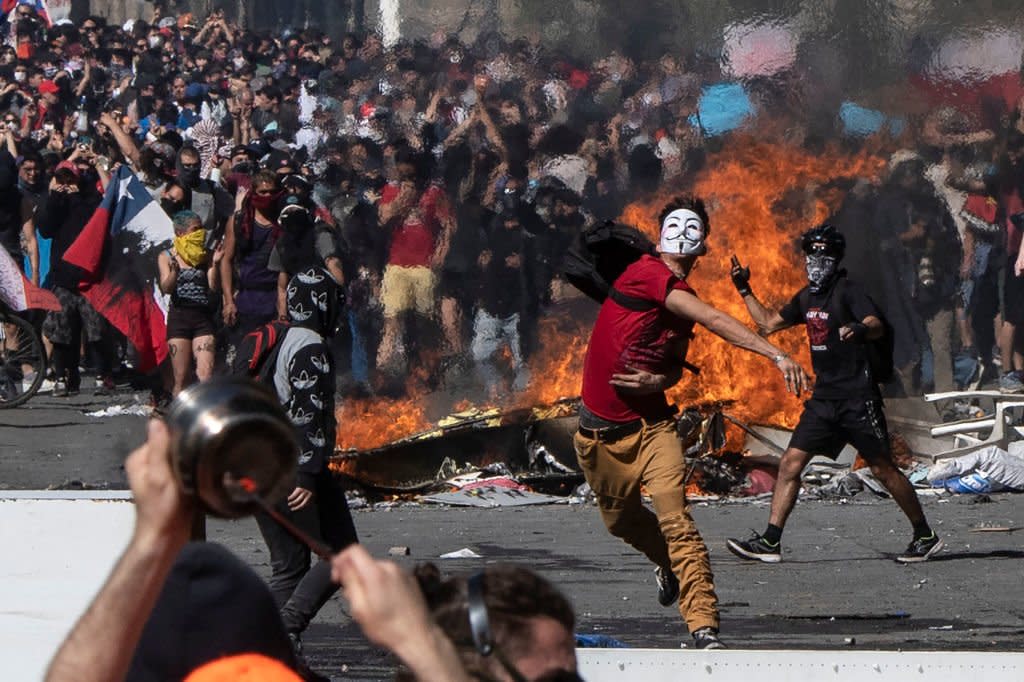Ciara Nugent, Time•January 16, 2020

With high-profile protests raging across Chile, Colombia, Hong Kong, Sudan, Algeria, Lebanon, India, Spain, France and more, last year it often felt as if much of the world was out in the streets.
A lot of it was. A report published Thursday by risk consultancy Verisk Maplecroft finds that a quarter of the world’s countries experienced a “surge” in civil unrest in 2019. And, the report’s authors say, that unrest is unlikely to die down in 2020.
Last year’s protests, spanning South America, Asia, Africa, the Middle East and Europe, have been compared to the late 1960’s, when civil rights, anti-war and anti-colonial movements, combined with the growth of a youth-led counter culture, prompted dramatic street protests in dozens of countries.
To understand what’s driving the current wave of discontent, and why it’s unlikely to recede this year, Verisk Maplecroft looked at what happened before protests broke out in the 47 countries that experienced an uptick of unrest in 2019.
- ADVERTISEMENT -
Governments in many of those countries implemented similar policies in the run up to the unrest, which could help to predict future outbreaks. The weakening of mechanisms for expressing discontent — such as restrictions on labor unions, or attacks on freedom of the press — was the number one predictor, taking place in 12 of the 47 countries. A series of authoritarian measures introduced in Russia in 2019, including a new law tightening restrictions on the internet and new limits placed on opposition candidates in local elections, inspired the country’s largest demonstrations in eight years.
The second most common indicator that people were about to take to the streets was cuts to fuel or food subsidies, with governments in 9 of the 47 countries making these. In Haiti, the government’s plans to lower fuel subsidies, which meant a 38% hike in gasoline prices and 47 % increase for diesel, set off anger over a long-running corruption scandal. In Iran, a fuel price hike prompted by U.S. sanctions sparked protests in a dozen cities, resulting in a bloody government crackdown.
As in Russia, Haiti and Iran, the protests in most countries have underlying causes that long pre-date triggers such as subsidy cuts or crackdowns. Often these grievances were very specific to the context and history of an individual country — as in Hong Kong’s pro-democracy movement, where fears that Beijing is seeking to undermine the territory’s special freedoms from China fueled outrage over a proposed bill to allow Hong Kong residents to be extradited to the mainland.
But many of the grievances are linked to global political and economic trends, Miha Hribernik, head of Asia Research at Verisk Maplecroft, tells TIME. “Stagnating incomes, growing income inequality, corruption, the loss of faith in established elites, and the erosion of civil and political rights were all among concerns that motivated people to protest in the 47 countries, although to varying degrees.”
Those issues may have boiled over in 2019, but they are “deeply entrenched” and it’s going to be hard for governments to address them, Verisk Maplecroft’s analysts found. “Policymakers across the globe have mostly reacted with limited concessions and a clampdown by security forces, but without addressing the underlying causes,” the report finds.
Some governments, as in Russia and Spain, have rejected protesters’ central demands outright: greater freedoms for dissent opposition parties and the option for the Catalan region to secede from Spain. Others have tried to mollify protesters by reversing the moves that triggered outrage — such as the Haiti’s fuel price hike, Hong Kong’s extradition bill, or Lebanon’s plan to tax WhatsApp calls.
But few leaders have offered the fundamental improvements on economic equality, corruption, political freedoms that many of the protest movements are demanding. Chile’s government has called a referendum on remaking the country’s dictatorship-era constitution in response to student-led protests over inequality and high costs of living. Even there, though, analysts say unrest will continue; the socioeconomic situation is unlikely to change enough to satisfy protesters in the short term, while fierce repression by security forces has angered the public further.
“According to our predictions, on average, 80% of [the 125 countries Verisk Maplecroft analysed] will see an uptick in protests over the next two years,” Hribernik says.
Already in the first two weeks of 2020, mass protests have returned to Chile, Lebanon, Iraq, Iran, Hong Kong, France, India and more. Last year’s global unrest may be about to become the new normal.
---30---
No comments:
Post a Comment